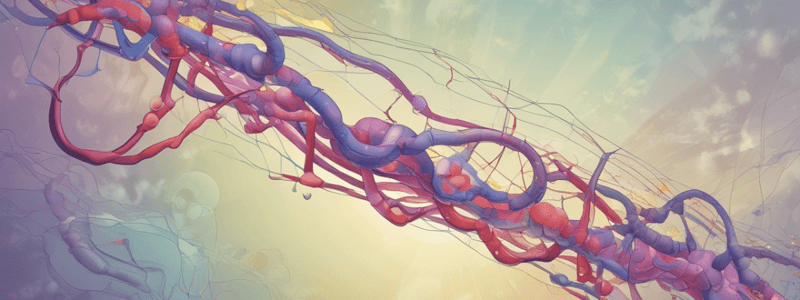Podcast
Questions and Answers
What is the function of Omega-3 fatty acids in the context of arachidonic acid metabolism?
What is the function of Omega-3 fatty acids in the context of arachidonic acid metabolism?
- Increase platelet aggregation
- Reduce vasodilation
- Increase leukotriene formation
- Give rise to 3-series prostaglandins (correct)
What is the effect of blocking COX-1 on the gastrointestinal system?
What is the effect of blocking COX-1 on the gastrointestinal system?
- Decrease gastric mucosa protection (correct)
- Increase platelet aggregation
- Increase gastric mucosa protection
- Have no effect on gastric mucosa protection
What is the role of COX-2 in the body?
What is the role of COX-2 in the body?
- Only expressed in the liver
- Always expressed everywhere in the body
- Only expressed in response to injury or inflammation (correct)
- Only expressed in the brain
What is the effect of NSAIDs on COX enzymes?
What is the effect of NSAIDs on COX enzymes?
What is the function of prostaglandin E2 (PGE2)?
What is the function of prostaglandin E2 (PGE2)?
What is the effect of zileuton on arachidonic acid metabolism?
What is the effect of zileuton on arachidonic acid metabolism?
Study Notes
Arachidonic Acid and Inflammation
- Arachidonic acid is a 20-carbon fatty acid with 4 double bonds.
- It is involved in the cycloxygenase pathway and enzymatic pathways.
- Enzymatic pathways include COX-1 and COX-2, which produce prostaglandins.
COX-1 and COX-2
- COX-1 is always expressed and protects the gastric mucosa.
- COX-2 is induced by injury and is involved in inflammation.
- NSAIDS (non-steroidal anti-inflammatory drugs) block both COX-1 and COX-2, but can cause gastric problems.
- Blocking COX-2 reduces inflammation and is beneficial for patients with high levels of PGE2.
Prostaglandins
- Prostaglandins are products of arachidonic acid and have various functions, including:
- Vasodilation and inhibition of platelet aggregation (PGI2).
- Pro-inflammatory effects (PGE2).
- Abortion (PGE2).
- Receptors for prostaglandins act on different targets, such as thrombosis and vasodilation.
Omega-3 Fatty Acids
- Omega-3 fatty acids reduce the formation of prostaglandins and leukotrienes.
- They give rise to 3-series prostaglandins, which are less potent than the 2-series.
Leukotrienes
- Leukotrienes are formed from arachidonic acid through the 5-lipoxygenase pathway.
- They have pro-inflammatory effects, including:
- Vasoconstriction.
- Increased permeability.
- Chemotaxis.
- Zileuton inhibits 5-lipoxygenase, reducing the formation of leukotrienes.
Inhibition of Inflammation
- Inhibiting the release of arachidonic acid from phospholipids can reduce inflammation.
- Blocking the action of phospholipase A2 can prevent the formation of prostaglandins and leukotrienes.
Studying That Suits You
Use AI to generate personalized quizzes and flashcards to suit your learning preferences.
Description
This quiz covers the role of arachidonic acid in the cyclooxygenase pathway, including its conversion to prostaglandins and the regulation of COX-1 and COX-2 enzymes. It also touches on the importance of these pathways in inflammation and the menstrual cycle.



